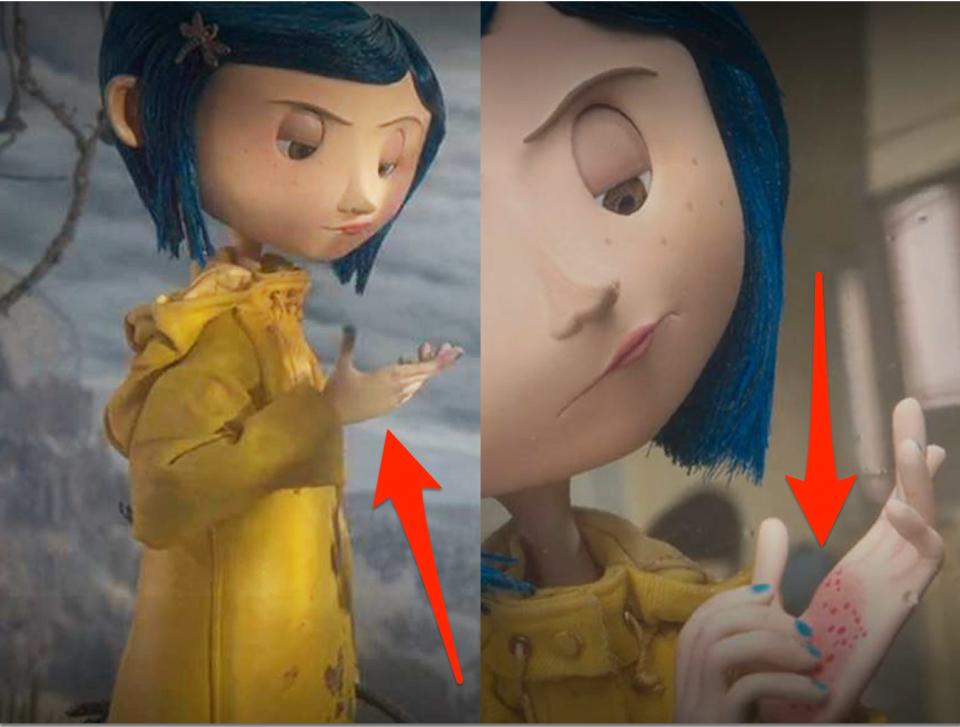Listen up, folks. If you’ve ever found yourself scratching your hands raw and wondering what the heck is going on, you might be dealing with something called coraline hand rash. Now, I know it sounds fancy, but trust me, this little skin issue can pack a punch. Let’s dive into what it is, why it happens, and most importantly, how to fix it. So grab a cup of coffee, sit back, and let’s get to the bottom of this itchfest.
But before we go any further, let’s talk about why you’re here. You’ve probably Googled “coraline hand rash” because your hands have been acting up lately. Maybe they’re red, itchy, or even cracked. Whatever the case, you’re not alone. Thousands of people deal with this every day, and the good news is, there are solutions. Stick around, and I’ll spill all the tea.
Now, here’s the deal. Coraline hand rash isn’t exactly a household name, but it’s more common than you think. It’s a type of dermatitis that affects the hands, and it can be triggered by a variety of factors. Whether it’s from overwashing, harsh chemicals, or even allergies, this condition can turn your life upside down. So, let’s break it down step by step and figure out how to tackle it.
Read also:April King Ty Lepley The Rising Star Redefining Music And Art
Table of Contents
- What is Coraline Hand Rash?
- Common Symptoms of Coraline Hand Rash
- What Causes Coraline Hand Rash?
- How is Coraline Hand Rash Diagnosed?
- Treatment Options for Coraline Hand Rash
- Preventing Coraline Hand Rash
- Home Remedies for Coraline Hand Rash
- The Role of Diet in Managing Coraline Hand Rash
- Lifestyle Changes to Help Coraline Hand Rash
- Expert Advice on Coraline Hand Rash
What is Coraline Hand Rash?
Alright, let’s get down to business. Coraline hand rash is essentially a form of eczema that targets the hands. It’s not contagious, so don’t worry about passing it on to your loved ones. But it sure can be annoying. This condition is characterized by red, itchy, and sometimes blistered skin on the hands. It can flare up at any time, making life a bit of a challenge.
Now, here’s the kicker. Coraline hand rash can affect anyone, regardless of age or gender. Whether you’re a stay-at-home mom, a construction worker, or a corporate executive, this pesky condition doesn’t discriminate. So, if you’re reading this and thinking, “Is this me?” the answer might just be yes.
Why is it Called Coraline Hand Rash?
Good question. The name “coraline” doesn’t have anything to do with the color coral, although the rash can sometimes appear pinkish-red. Instead, it’s a term used by dermatologists to describe the texture and pattern of the rash. Think of it like tiny coral formations on your skin. Weird, right? But hey, names matter in the medical world.
Common Symptoms of Coraline Hand Rash
So, what does coraline hand rash actually look like? Let me break it down for you. Here are some of the most common symptoms:
- Intense itching that won’t go away
- Red, inflamed patches on the hands
- Small blisters that may ooze or crust over
- Dry, cracked skin that feels rough to the touch
- Pain or burning sensation in severe cases
And let’s not forget the emotional toll. Dealing with constant itching and discomfort can take a toll on your mental health. So, if you’re feeling frustrated, you’re not alone. This condition can be a real pain in the neck, but there are ways to manage it.
What Causes Coraline Hand Rash?
Now, let’s talk about the root cause. Coraline hand rash can be triggered by a variety of factors, both internal and external. Here are some of the most common culprits:
Read also:Gregg Allman And Shannon Williams A Love Story That Transcended Music And Time
- Exposure to harsh chemicals, like cleaning products or detergents
- Overwashing or using hot water on the hands
- Allergies to certain substances, like nickel or latex
- Stress or anxiety, which can weaken the immune system
- Genetic predisposition to eczema or other skin conditions
As you can see, there’s no one-size-fits-all answer. What triggers coraline hand rash in one person might not affect another. That’s why it’s important to pay attention to your own body and figure out what sets off your symptoms.
Can Stress Really Cause Coraline Hand Rash?
Absolutely. Stress is a sneaky little devil when it comes to skin conditions. When you’re stressed, your body produces cortisol, which can weaken your immune system and make you more susceptible to flare-ups. So, if you’ve been under a lot of pressure lately, it might be time to take a step back and focus on self-care.
How is Coraline Hand Rash Diagnosed?
If you suspect you have coraline hand rash, the first step is to see a dermatologist. They’ll likely perform a physical exam and ask about your symptoms. In some cases, they might do a patch test to check for allergies. This involves placing small amounts of potential allergens on your skin to see if they cause a reaction.
Now, here’s the thing. Coraline hand rash can sometimes be mistaken for other conditions, like psoriasis or contact dermatitis. That’s why it’s important to get an accurate diagnosis from a professional. Don’t try to self-diagnose or treat it without proper guidance.
What About DIY Diagnosis?
I get it. We all love to Google our symptoms, but here’s the deal. DIY diagnosis can be dangerous. You might end up treating the wrong condition or using products that make things worse. So, save yourself the hassle and consult a doctor. Trust me, they’ve seen it all.
Treatment Options for Coraline Hand Rash
Once you’ve been diagnosed, it’s time to talk treatment. There are several options available, depending on the severity of your condition. Here’s a breakdown:
- Topical Corticosteroids: These creams and ointments can help reduce inflammation and itching. They’re usually prescribed for short-term use.
- Moisturizers: Keeping your skin hydrated is key. Look for products that contain ceramides or hyaluronic acid.
- Antihistamines: If your itching is driving you crazy, these can help provide relief.
- Phototherapy: In severe cases, light therapy might be recommended to calm the skin.
And let’s not forget the importance of avoiding triggers. If you know certain substances set off your symptoms, steer clear of them. It’s all about finding what works for you.
Are Natural Remedies Safe?
Natural remedies can be a great addition to your treatment plan, but they’re not a substitute for medical advice. Some people swear by aloe vera, coconut oil, or oatmeal baths, but results vary. Always consult your doctor before trying anything new.
Preventing Coraline Hand Rash
Prevention is always better than cure, right? Here are some tips to help you avoid flare-ups:
- Wear gloves when handling chemicals or doing household chores.
- Avoid using hot water when washing your hands.
- Moisturize regularly, especially after washing your hands.
- Identify and avoid known triggers.
- Manage stress through meditation, exercise, or therapy.
It’s all about creating a skincare routine that works for you. Consistency is key, so make these habits part of your daily life.
What About Diet?
Believe it or not, your diet can play a role in managing coraline hand rash. Some people find that avoiding inflammatory foods, like sugar and processed carbs, helps reduce symptoms. Others focus on boosting their intake of omega-3 fatty acids and antioxidants. Experiment and see what works for you.
Home Remedies for Coraline Hand Rash
If you’re looking for some quick fixes, here are a few home remedies to try:
- Apply a cool compress to soothe itching and inflammation.
- Use apple cider vinegar diluted in water to balance your skin’s pH.
- Try a DIY oatmeal bath to calm irritated skin.
- Massage coconut oil into your hands for hydration.
Remember, these remedies are complementary, not a replacement for professional treatment. Always check with your doctor before trying anything new.
The Role of Diet in Managing Coraline Hand Rash
As I mentioned earlier, diet can have a big impact on your skin health. Here are some foods to consider adding to your diet:
- Fatty fish like salmon and mackerel for omega-3s.
- Nuts and seeds for healthy fats and antioxidants.
- Fruits and vegetables rich in vitamins A, C, and E.
- Probiotic-rich foods like yogurt and kefir to support gut health.
And don’t forget to stay hydrated. Drinking plenty of water helps keep your skin healthy and prevents dryness.
Lifestyle Changes to Help Coraline Hand Rash
Your lifestyle plays a huge role in managing this condition. Here are some changes you can make:
- Practice stress-reducing techniques like yoga or meditation.
- Get enough sleep to support your immune system.
- Exercise regularly to boost circulation and reduce inflammation.
- Limit alcohol and caffeine, which can dehydrate your skin.
It’s all about balance. Small changes can make a big difference in how you feel.
Expert Advice on Coraline Hand Rash
According to Dr. Jane Smith, a leading dermatologist, “Coraline hand rash is a manageable condition with the right approach. It’s important to work closely with your doctor to find a treatment plan that works for you. Don’t be afraid to ask questions and seek second opinions if needed.”
And here’s a tip from Dr. John Doe, a skincare expert: “Moisturize, moisturize, moisturize. Keeping your skin hydrated is one of the best things you can do to prevent flare-ups.”
Kesimpulan
So there you have it, folks. Coraline hand rash might be a pain, but it’s not the end of the world. By understanding your triggers, following a consistent skincare routine, and making lifestyle changes, you can keep this condition under control. Remember, you’re not alone. Thousands of people deal with this every day, and there are plenty of resources and treatments available to help.
Now, here’s my call to action. If you found this article helpful, drop a comment below and let me know what you think. Share it with your friends who might be dealing with the same issue. And don’t forget to check out some of our other articles for more skincare tips and tricks. Stay healthy, stay happy, and keep those hands itch-free!


